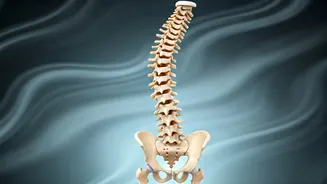Understanding Back Pain
Back pain is a widespread issue, and its causes extend beyond just physical strain. Factors like poor posture, which involves how you sit, stand, and move,
can cause undue stress on the spine. Additionally, the pressures and anxieties of daily life greatly contribute to musculoskeletal tension, affecting back health. These issues often intertwine, making back pain a multi-faceted problem. It is essential to recognize the roles of both physical alignment and emotional well-being to address the problem effectively. The goal is to move beyond superficial solutions and find remedies. This approach considers both the physical and mental elements of back pain, thereby promoting a holistic healing process.
The Posture Puzzle
Poor posture represents a key player in the development of back pain. Whether you are sitting at a desk, walking, or even sleeping, maintaining incorrect alignment can strain the spinal structures. A slumped posture, for example, puts increased pressure on spinal discs and ligaments, predisposing one to pain and discomfort. Over time, these postural imbalances can lead to chronic back issues. Correcting posture involves becoming mindful of your body's positioning throughout the day. This can be achieved through regular checks, ergonomic adjustments to your workspace, and incorporating exercises that strengthen core muscles, which are crucial for supporting the spine. Such steps promote not only immediate relief but also long-term spinal health. It is an investment in your well-being.
Stress's Hidden Impact
Stress, a ubiquitous part of modern life, has a significant and often underestimated effect on back health. When the body experiences stress, muscles tend to tense up, including those in the back. Prolonged stress can lead to chronic muscle tension and inflammation, worsening back pain. Stress also influences pain perception, making existing discomfort feel more intense. Furthermore, the behavioral responses to stress, such as poor posture and lack of physical activity, can exacerbate the problem. Managing stress is, therefore, an essential part of a comprehensive approach to back pain relief. This can involve techniques such as meditation, deep breathing exercises, and yoga, or finding more time for relaxing activities.
Lifestyle and Back Pain
Our daily lifestyle choices heavily influence back pain. Prolonged sitting, common in many jobs, contributes to poor posture and decreased core strength. Conversely, regular physical activity helps strengthen the muscles supporting the spine and increases flexibility, reducing the risk of back pain. Diet also plays a role. An unbalanced diet can lead to inflammation, impacting back health. Additionally, adequate sleep is essential for the body to recover and repair. Making proactive lifestyle changes, such as incorporating regular exercise, maintaining a balanced diet, practicing good posture, and prioritizing adequate rest can drastically reduce the prevalence of back pain. These lifestyle modifications are a cornerstone in building and maintaining back health, which is vital to a happy life.
Seeking Solutions & Relief
Finding relief from back pain demands a strategic and tailored approach. Treatment options range from conservative measures to more involved therapies, with many available interventions to address pain. Physical therapy often involves exercises to strengthen back muscles and improve posture. Over-the-counter pain relievers can alleviate discomfort, while in some cases, stronger medications may be prescribed. For persistent or severe back pain, medical interventions like injections or, in rare instances, surgery may be necessary. Complementary therapies, like acupuncture, may also offer relief. Finding the right solution usually involves a combination of these approaches, adjusted to your specific needs. Consulting with a healthcare professional to identify the best treatment plan is always recommended.













